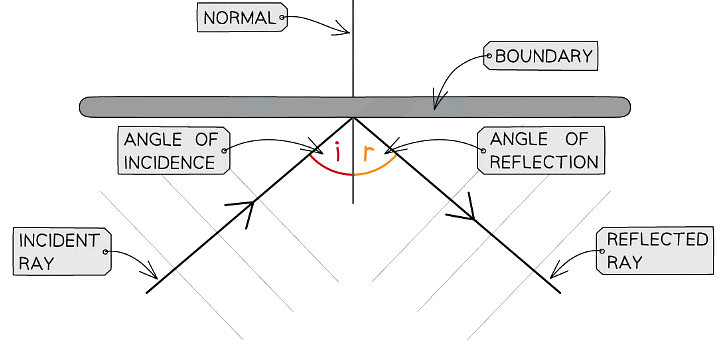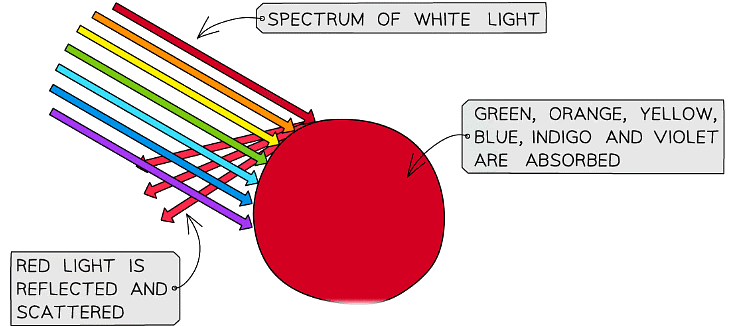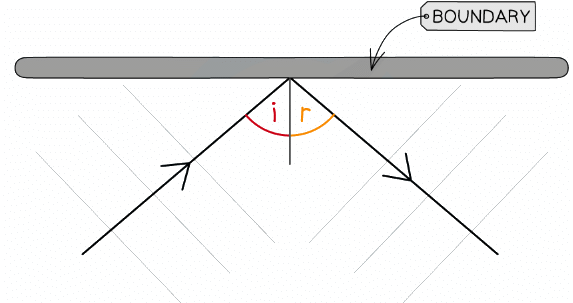Grade 10 Exam > Grade 10 Notes > Physics for Grade 10 > Reflection, Absorption & Transmission
Reflection, Absorption & Transmission | Physics for Grade 10 PDF Download
| Table of contents |

|
| Reflection |

|
| Transmission |

|
| Absorption |

|
| Reflection Ray Diagrams |

|
Depending on the densities of the materials on either side of a boundary, a wave may be:
- Reflected
- Transmitted
- Absorbed
Reflection
- Reflection occurs when:
A wave hits a boundary between two media and does not pass through, but instead stays in the original medium - The law of reflection states:
 Reflection of a wave at a boundary
Reflection of a wave at a boundary- Some of the wave may also be absorbed or transmitted
- Echos are examples of sound waves being reflected off a surface
- Flat surfaces are the most reflective
- The smoother the surface, the stronger the reflected wave is
- Rough surfaces are the least reflective
- This is because the light scatters in all directions
- Opaque surfaces will reflect light which is not absorbed by the material
- The electrons will absorb the light energy, then reemit it as a reflected wave
Transmission
- Transmission occurs when:
A wave passes through a substance - For light waves, the more transparent the material, the more light will pass through
- Transmission can involve refraction but is not exactly the same
- For the process to count as transmission, the wave must pass through the material and emerge from the other side
- When passing through a material, waves are usually partially absorbed
- The transmitted wave may have a lower amplitude because of some absorption
- For example, sound waves are quieter after they pass through a wall
 When a wave passes through a boundary it may be absorbed and transmitted
When a wave passes through a boundary it may be absorbed and transmitted
Absorption
- Absorption occurs when:
Energy is transferred from the wave into the particles of a substance - Waves can be partially or completely absorbed
- Sound waves are absorbed by brick or concrete in houses
- Light will be absorbed if the frequency of light matches the energy levels of the electrons
- The light will be absorbed, and then reemitted over time as heat
- If an object appears red, this means:
- Only red light has been reflected
- All the other frequencies of visible light have been absorbed
 The object is seen as red since the red light is reflected whilst the other colours are absorbed
The object is seen as red since the red light is reflected whilst the other colours are absorbed
 |
Download the notes
Reflection, Absorption & Transmission
|
Download as PDF |
Download as PDF
Reflection Ray Diagrams
- Angles are measured between the wave direction (ray) and a line at 90 degrees to the boundary
- The angle of the wave approaching the boundary is called the angle of incidence (i)
- The angle of the wave leaving the boundary is called the angle of reflection (r)
- The law of reflection states that these angles are the same:
Angle of incidence (i) = Angle of reflection (r)
 Reflection of a wave at a boundary
Reflection of a wave at a boundary
- When drawing a ray diagram an arrow is used to show the direction the wave is travelling
- An incident ray has an arrow pointing towards the boundary
- A reflected ray has an arrow pointing away from the boundary
- The angles of incidence and reflection are usually labelled i and r respectively
Exam Tip
When drawing ray diagrams, a simple line with an arrow is enough to represent the wave. You do not need to draw the wavefronts unless asked to do so!
The document Reflection, Absorption & Transmission | Physics for Grade 10 is a part of the Grade 10 Course Physics for Grade 10.
All you need of Grade 10 at this link: Grade 10
|
124 videos|149 docs|37 tests
|
Related Searches



















